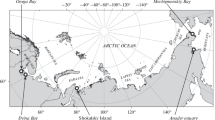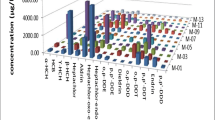Abstract
Five bulked human adipose tissue samples were analyzed for individual polychlorinated biphenyl (PCB) congeners (including selected non-ortho-substituted compounds) and polychlorinated dibenzo-p-dioxins and furans (PCDD/Fs). Mean ΣPCB and ΣPCDD/F (tetra-through octachlorinated homologues) concentrations were 0.75 μg/g and 1.22 ng/g adipose tissue respectively. Both the congener patterns and levels detected were similar to those reported by laboratories in other industrialised countries. Each sample comprised of tissue taken from donors within a given locality. However, no obvious relationships were apparent between sampling area, absolute concentrations and congener pattern of PCBs and PCDD/Fs.
The contribution of individual PCDD/F and non -ortho-(o), mono-o-, and di-o-substituted PCB congeners to the total calculated toxic equivalent values (ΣTEQ) was assessed for each sample. The main contributions to the ΣTEQ were the mono-o-substituted PCB congeners #118 (TEQ=42.5 pg/g of lipid), #156 (TEQ=24.8 pg/g) and #105 (TEQ=20.7 pg/g), followed by 1,2,3,6,7,8-HxCDD (TEQ=18.2 pg/g), 2,3,4,7,8-P5CDF (TEQ= 12 pg/g), 1,2,3,7,8-P5CDD (TEQ=11.5 pg/g), and the non-o-substituted PCB congener #126 (TEQ =11.3 pg/g). Collectively, these compounds accounted for 80% of the STEQ values. Based on the TEFs proposed by Safe (1990), the overall TEQs calculated for the monitored PCBs, were twice those due to ΣPCDD/Fs.
Similar content being viewed by others
References
Abbott DC, Goulding R, Holmes DC, Hoodless RA (1985) Organochlorine pesticide residues in human fat in the United Kingdom 1982–1983. Hum Toxicol 4:435–444
Ballschmiter K, Zell M (1980) Analysis of PCBs by glass capillary gas chromatography. Fresenius Z Anal Chem 302:20–31
de Boer J, Stronck CJN, van der Valk F, Wester PG, Daudt MJM (1991) Analysis of non-ortho and mono-ortho substituted chlorobiphenyls in fish, presented at the 11th International Symposium on Chlorinated Dioxins and Related Compounds (Dioxin '91), Raleigh, NC, September 1991
de Voogt P, Well DE, Reutergardh L, Brinkman VA (1990) Review: Biological activity determination and occurrence of planar, monoand di-ortho PCBs. Int J Environ Anal Chem 40:1–46
Department of the Environment (DoE) (1989) Dioxins in the environment. Pollution Paper No. 27, HMSO, London
Dewailly E, Weber J-P, Gingras S, Laliberté C (1991) Coplanar PCBs in human milk in the Province of Québec, Canada: Are they more toxic than dioxin for breast fed infants? Bull Environ Contain Toxicol 47:491–498
Duarte-Davidson R, Burnett V, Waterhouse KS, Jones KC (1990) A congener specific method for the analysis of polychlorinated biphenyls (PCBs) in human milk. Chemosphere 23:119–131
Focardi S, Romei R (1987) Fingerprint of polychlorinated biphenyl congeners in samples of human subcutaneous adipose tissue. Chemosphere 16:2315–2320
Gomez-Catalan J, Sabroso M, To-Figueras J, Planas J, Corbella J (1991) PCB residues in the adipose tissue of the population of Barcelona (Spain). Bull Environ Contam Toxicol 47:504–507
Harrad SJ, Sewart AS, Boumphrey R, Duarte-Davidson R, Jones KC (1992a) A method for the determination of PCB congeners 77, 126 and 169 in biotic and abiotic matrices. Chemosphere 24:1147–1154
Harrad SJ, Sewart AS, Berrow ML, Jones KC (1992b) PCDDs and PCDFs: Their persistence in sewage sludge-amended agricultural soils and increases in soil concentrations since 1968. Chemosphere (submitted)
Jones KC, Bennett BG (1989) Human exposure to environmental polychlorinated dibenzo-p-dioxins and dibenzofurans: an exposure commitment assessment for 2,3,7,8-TCDD. Sci Total Environ 78:99–116
Kee M (1983) Polychlorinated biphenyls in human tissue. Nature 303:653
Luotamo M (1991) Congener specific assessment of human exposure to polychlorinated biphenyls. Chemosphere 23:1685–1698
Mes J (1990) Trends in the levels of some chlorinated hydrocarbon residues in adipose tissue of Canadians. Environ Pollut 65:269–278
NATO/Committee on the Challenges of Modern Society (CCMS) (1988) International Toxicity Equivalency Factor (I-TEF) Method of risk assessment for complex mixtures of dioxins and related compounds. Pilot study on international information exchange on dioxins and related compounds. CCMS Report No. 176. Environmental Protection Agency, Washington, DC
Patterson DG, Todd GD, Turner WE, Issacs SG, Needham LL (1990) Levels of non-ortho substituted polychlorinated biphenyls, dibenzo-p-dioxins and dibenzofurans in human serum and adipose tissue. In: Hutzinger O, Fiedler H (eds) Organohalogen compounds 1: Dioxin '90—EPRI SEMINAR. Ecoinforma Press, Bayreuth, Germany, pp 133–136
Ryan JJ, Lizotte R, Lau BP-Y (1985) Chlorinated dibenzo-p-dioxins and chlorinated dibenzofurans in Canadian human adipose tissue. Chemosphere 14:697–706
Safe S (1990) Polychlorinated biphenyls (PCBs), dibenzofurans (PCDFs) and related compounds: environmental and mechanistic considerations which support the development of Toxic Equivalency Factors (TEFs). Crit Rev Toxicol 21:51–88
Safe S, Yao C, Davis D (1990) Development of toxic equivalency factors for polychlorinated biphenyls (PCBs). In: Hutzinger O, Fiedler H (eds) Organohalogen compounds 1: Dioxin '90—EPRI SEMINAR. Ecoinforma Press, Bayreuth, Germany, pp 55–59
Schulz DE, Petrick G, Duinker JC (1989) Complete characterization of polychlorinated biphenyl congeners in commercial Aroclor and Clophen mixtures by multidimensional gas chromatography-electron capture detection. Environ Sci Technol 23:852–859
Tanabe S, Kannan N, Subramanian A, Watanabe S, Tatsukawa R (1987) Highly toxic coplanar PCBs: occurrence, source, persistency and toxic implications to wildlife and humans. Environ Pollut 47:147–163
Williams DT, Leßel GL (1990) Polychlorinated biphenyl congener residues in human adipose tissue samples from five Ontario municipalities. Chemosphere 20:33–42
—,— (1991) Coplanar polychlorinated biphenyl residues in human adipose tissue samples from Ontario Municipalities. Chemosphere 22:1019–1028
Author information
Authors and Affiliations
Rights and permissions
About this article
Cite this article
Duarte-Davidson, R., Harrad, S.J., Allen, S. et al. The relative contribution of individual polychlorinated biphenyls (PCBs), polychlorinated dibenzo-p-dioxins (PCDDs) and polychlorinated dibenzo-p-furans (PCDFs) to toxic equivalent values derived for bulked human adipose tissue samples from Wales, United Kingdom. Arch. Environ. Contam. Toxicol. 24, 100–107 (1993). https://doi.org/10.1007/BF01061096
Received:
Revised:
Issue Date:
DOI: https://doi.org/10.1007/BF01061096




